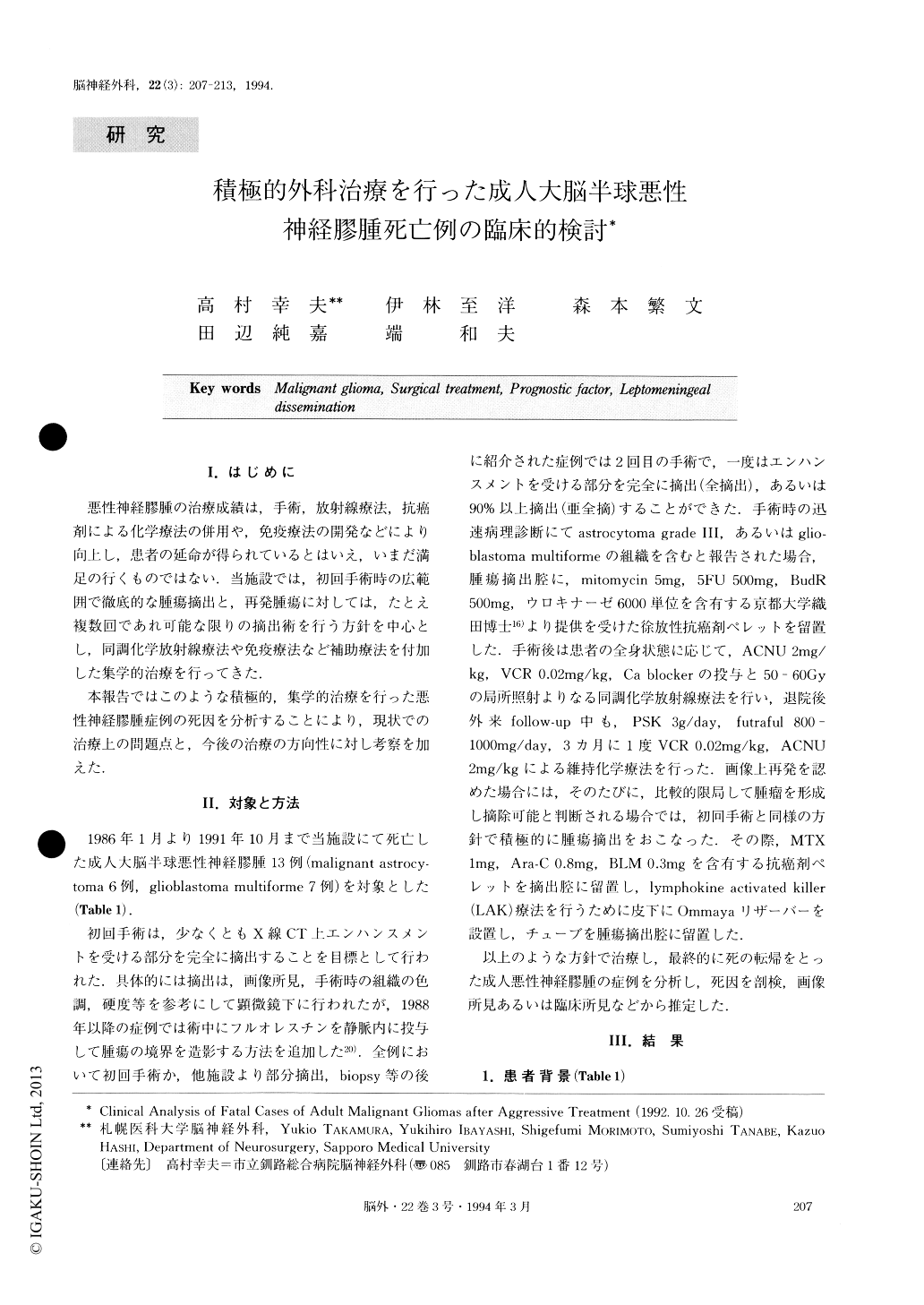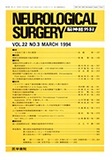Japanese
English
- 有料閲覧
- Abstract 文献概要
- 1ページ目 Look Inside
I.はじめに
悪性神経膠腫の治療成績は,手術,放射線療法,抗癌剤による化学療法の併用や,免疫療法の開発などにより向上し,患者の延命が得られているとはいえ,いまだ満足の行くものではない.当施設では,初回手術時の広範囲で徹底的な腫瘍摘出と,再発腫瘍に対しては,たとえ複数回であれ可能な限りの摘出術を行う方針を中心とし,同調化学放射線療法や免疫療法など補助療法を付加した集学的治療を行ってきた.
本報告ではこのような積極的,集学的治療を行った悪性神経膠腫症例の死因を分析することにより,現状での治療上の問題点と,今後の治療の方向性に対し考察を加えた.
Six patients operated on for supratentorial malignant astrocytomas and seven patients operated on for glio-blastoma multiforme were analyzed to evaluate the effect of aggressive surgical resection on the length of survival and causes of death. Early postoperative con-trast enhanced CT scan was used to assess the extent of surgical resection. A gross total resection was consi-dered to have been accomplished when there was no evidence of any residual enhanced mass. When 10% or less of the preoperative enhanced mass remained, the resection was classified as a subtotal resection. Subse-quent follow-up CT scan showed that a gross total re-section was accomplished in nine patients, and a subtot-al resection was attained in four patients. The patients' ages ranged from 90 to 78 years (mean, 59 years). The median survival after the first aggressive surgical resec-tion was 18.0 months in patients with malignant astrocytoma and 13.6 months in those with glioblasto-ma multiforme. The median duration between first op-eration and recurrence of tumor was 8.8 months in pa-tients with malignant astrocytoma and 11.5 months in those with glioblastoma multiforme. A second aggres-sive surgical resection for recurrent malignant astrocy-toma or glioblastoma multiforme was carried out in four patients (40%) of the evaluated ten patients. The median survival of these patients after reoperation was 8.25 months.
Accordingly, aggressive surgical resection of malig-nant astrocytoma and glioblastoma multiforme is corre-lated with longer survival and is advocated in the treat-ment of recurrent tumors.
Leptomeningeal dissemination was diagnosed in nine patients (90%) of evaluated ten patients. The median interval between the first aggressive surgical resection and leptomeningeal dissemination was 11.7 months in patients with malignant astrocytoma and 15.0 months in those with glioblastoma multiforme. The median sur-vival after dissemination was 5.3 months. It was strong-ly suggested that clinical evidence of leptomeningeal dissemination is significantly related to prognosis after aggressive surgical resection.
The causes of death were divided into the following three groups: Group Ⅰ, leptomeningeal dissemination, 8 patients; Group Ⅱ, massive local recurrence, 2 patients; Group Ⅲ, postoperative complications, 3 pa-tients. The patients with dissemination which was sus-pected to be the cause of death occupied 62% of this series. These findings suggest that aggressive surgical resection is a beneficial therapeutic procedure for malignant supratentorial gliomas, however the number of patients who died from leptomeningeal dissemination and diffuse parenchymal infiltration increased. We found two types of patients with leptomeningeal dissemination as follows:(a) CT scan revealed marked intra ventricular dissemination or spinal seeding in con-trast to slight invasion of the primary tumor.(b) CT scan revealed diffuse tumor invasion in subcortical white matter in contrast to slight subependymal dis-semination.
These results indicate that clinical manifestations of leptomeningeal dissemination or diffuse tumor invasion in subcortical white matter should be considered as grave prognostic factors after treatment with aggressive surgical therapy for malignant supratentorial gliomas.

Copyright © 1994, Igaku-Shoin Ltd. All rights reserved.


